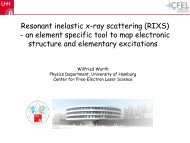Joe Frisch: Synchrotron radiation sources and free ... - Conferences
Joe Frisch: Synchrotron radiation sources and free ... - Conferences
Joe Frisch: Synchrotron radiation sources and free ... - Conferences
You also want an ePaper? Increase the reach of your titles
YUMPU automatically turns print PDFs into web optimized ePapers that Google loves.
Seeding<br />
• FEL light is amplified noise: 10-100X transform limited b<strong>and</strong>width.<br />
• Would like to generate low power, narrow b<strong>and</strong> seed light, then amplify in<br />
the undulator.<br />
– Allows control of b<strong>and</strong>width, pulse length etc.<br />
• Difficult: seed needs ~MW peak power in narrow b<strong>and</strong>, tunable X-rays<br />
• Self Seeding: Use a short undulator to generate spontaneous emission,<br />
then filter to generate seed<br />
– For hard X-rays can use Bragg diffraction from crystals.<br />
– For soft X-rays can use grazing incidence gratings<br />
• Laser seeding: Generate high harmonics of a conventional laser<br />
– Direct generation of laser harmonics in a gas<br />
– Generation of harmonics in an undulator, then repeat (harmonic cascade)<br />
– ECHO harmonic generation (described later)<br />
– Laser seeding looks difficult for hard x-rays!<br />
• Laser seeding experiments under way at DESY / FLASH (sFLASH), <strong>and</strong> Fermi<br />
ELETTRA. Self-seeding experiment planned at LCLS in fall 2011.<br />
• Seeding provides a large improvement in the performance of XFELs,<br />
included at least as an option in all new designs.<br />
33



